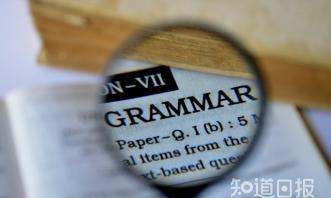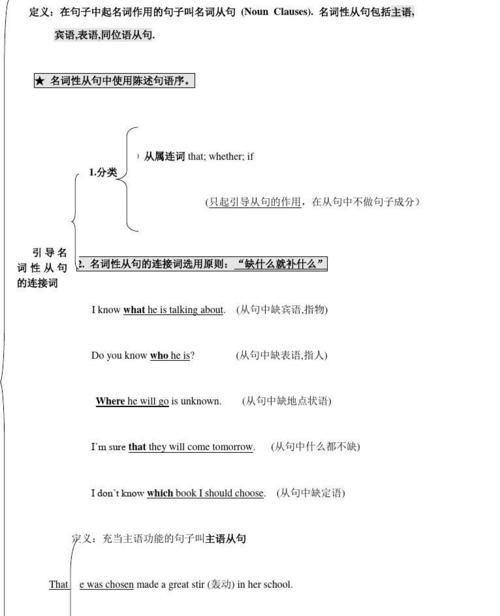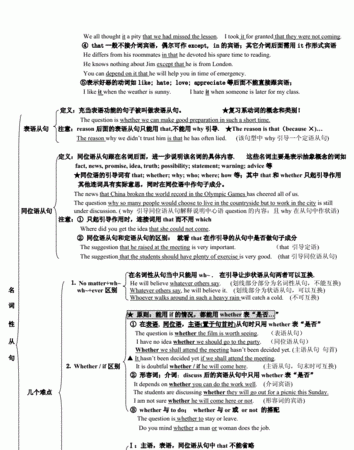说起名词性从句的用法归纳总结 网上有很多解释,有必要科普一下,名词性从句的引导词有哪些?用法怎样?和名词性从句的用法名词性从句的用法归纳总结 的内容,方便您深入了解高中名词性从句有哪些,一起深入了解。
名词性从句的用法归纳总结 :名词性从句相关知识点
英语语法名词性从句知识:概念和用法介绍
2 英语语法名词性从句知识点:whether 和if引导名词性从句
3 英语语法名词性从句知识点:that, why 与 because 引导表语从句
4 英语语法名词性从句知识点:八种宾语从句不省略that
5 英语语法名词性从句知识点:that与whether引导名词性从句
6 英语语法名词性从句知识点:the fact that引导主语从句
7 英语语法名词性从句知识点:名词性从句的关键点
8 英语语法名词性从句知识点:except宾语的6种不同从句
9 英语语法名词性从句知识点:理解引导名词性从句的what
10 英语语法名词性从句知识点:what与that引导名词性从句区别
11 英语语法名词性从句知识点:whoever与no matter who的区别
12 英语语法名词性从句知识点:that if是什么意思
13 英语语法名词性从句知识点:形容词可用作状语吗
14 英语语法名词性从句知识点:宾语从句的时态呼应
15 英语语法名词性从句知识点:关系代词怎样省略
16 英语语法名词性从句知识点:引导的主语从句的what
17 英语语法名词性从句知识点:whatever引导主语从句的用法
18 英语语法名词性从句知识点:四类名词性从句详解
19 英语语法名词性从句知识点:这个答句是什么从句
20 英语语法名词性从句知识点:whichever引导主语从句的用法
21 英语语法名词性从句知识点:whoever引导主语从句的用法
22 英语语法名词性从句知识点:同位语从句的引导词问题
23 英语语法名词性从句知识点:同位语从句与定语从句的区别
24 英语语法名词性从句知识点:怎样学好名词性从句?
25 英语语法名词性从句知识:名词性从句基础
26 英语语法名词性从句知识:八种宾语从句不省略that
27 英语语法名词性从句知识:宾语从句学习指要
28 英语语法名词性从句知识:同位语从句学习指要
29 英语语法名词性从句知识:表语从句学习指要
30 英语语法名词性从句知识:主语从句学习指要
31 英语语法名词性从句知识:名词性从句用法详解
32 英语语法名词性从句知识:同位语边缘知识归纳
33 英语语法名词性从句知识:关系型 what引导名词性从句
34 英语语法名词性从句知识:四组名词性从句
35 英语语法名词性从句知识:应注意的两个问题
36 英语语法名词性从句知识:同位语从句用法详解
37 英语语法名词性从句知识:表语从句用法详解
38 英语语法名词性从句知识:宾语从句用法详解
39 英语语法名词性从句知识:主语从句用法详解
大概就这些,你可以自己再总结一下哈

名词性从句的用法归纳总结 :英语语法名词性从句
英语中 不乏大量的名词性从句。名词性从句是由名词和动词组成的一组单词。
名词是人的名字、动物、地点、事物或者一种状态,比如快乐hapiness或者兴奋excitement。
换句话说,名词就是某人或某物的称呼。
名词意味着名字
代词it, she, you, him, this等等可以取代名词。如果发现用一个代词可以取代一组单词,那么这组单词即为名词短语。我们来看下几个例子:
 名词从句可以在句子中作主语、宾语或者补语。
名词从句可以在句子中作主语、宾语或者补语。
做主语:Whatever Taylor Swift sings becomes a hit.
It becomes a hit.
作宾语:Did you know that Taylor Swift is only twenty-five?
Did you know this?
作主语补足语:
Taylor Swift’s beauty and talent are what many girls dream of.
Taylor Swift’s beauty and talent are this.
名词从句通常可以通过对句子剩余部分提问来辨认。
比如说:
What becomes a hit? 答案即是whatever Taylor Swift sings
What did I know? 答案为:that Taylor Swift is only twenty-five?
What are Taylor Swift’s beauty and talent? 答案是:what many girls dream of.
明白了吗?
名词性从句很容易辨认,通常由以下词引导
that, if, whether,
what, when,how, where, 还有:
whatever,whenever, however.
You can tell me when it’s over if the high was worth the pain. 这句话里如何用this或it来替代句子成分呢?
这句话里包含了2个名词从句
1 You can tell me when it’s over
2. You can tell me if the high was worth the pain.
You can tell me ‘this’
待续。请继续关注Jason老师
想过你为什么没学好英语吗?
因为你没有真正的掌握英语学习的方法!
学英语不能输在起跑线上,
关注我们微信Jason-English8,学习别人不会告诉你的英语学习方法,真正的进入英语世界!
名词性从句的用法归纳总结 :名词性从句的用法
名词性从句就是句子担任名词性的成分,如主语,宾语,表语,同位语。它包括主语从句、宾语从句、表语从句和同位语从句。
1. 主语从句
(1)What he said is true.
(2)When they will arrive is not known yet.
(3)That he succeeded in doing the experiment was encouraging.
(4)Whether he will accept the invitation remains a secret.
(5)It is important that we should learn English well.
2. 宾语从句
(1)I don't know if he has done the work.
(2)Did he say that he liked football ?
(3)They expected that they would be given another chance.
(4)The girl told me that she had longed to visit China.
3. 表语从句
(1)The question is whether we have enough time to do the experiment again.
(2)His greatest wish was that someday he would become a general.
(3)His suggestion was that we should discuss the plan carefully.
(4)My question is when they can finish the work.
4. 同位语从句
(1)You have no idea how eager they are to know the result.
(2)He made a suggestion that the work should be given to him.
(3)Have you heard the news that Premire Wen visited our school last Friday ?
(4)The fact that he got full mark in the composition made his parents very happy.
名词性从句主要从以下几点把握:
1. 语序。从句一定要是陈述语序。如:
(1)These pictures will show you what the village looks like now.
(2)How many guests will be invited isn’t decided yet.
2. 时态。宾语从句的时态需要和主句进行协调。如主句是过去时,从句要用相应的过去时。
(1)He told me that he had seen the film.
(2)They said they would spend their holiday in Hainan.
(3)Father said he was carrying out an important project.
(4)Did you know where the accident took place ?
3. 连词。引导名词性从句的连词分为三种:连词 that, whether, if (在主语、表语、同位语从句中用 whether 不用if );连接代词 who, whom, whose, which, what 等; 连接副词 when, where, how, why 等。
(1)Whether the team has won the game is not announced yet. (主语从句)
(2)How many people will take part in the competition will be known soon. (主语从句)
(3)My idea is that we should spend our holidays by the seaside. (表语从句)
(4)My question is how they finished the work in such a short time. (表语从句)
(5)Many people are shocked at the news that there are so many SARS cases in Beijing. (同位语从句)
(6)His suggestion that we should discuss the plan again has been received. (同位语从句)
(7)I didn’t know if they had seen the film. (宾语从句)
(8)We haven’t decided when we’ll start the project. (宾语从句)
4. 形式主语和形式宾语的应用:
当主语从句比较长,主句比较短时,通常用形式主语it,而把从句放在后面,如:
(1)It is said that they have succeeded in working out the problem.
(2)It was important that we should make the plan carefully.
(3)It remains a secret how the animals came to live in the sea.
当宾语从句后面有补语的时候,我们也需要用形式宾语it, 而将宾语从句放在补语之后,如:
(1)I found it very difficult that one learns several languages at the same time.
(2)He thinks it necessary that we should be given more time practising oral English.
(3)He made it clear that he would leave the office soon.
5. 虚拟语气在名词性从句中的运用: 在demand, insist, suggest, command, require, request, order, propose 等表示命令, 要求,请求,建议等意义的动词后,宾语从句要用虚拟语气,动词形式为: should do , should 可省,直接用动词原形,如:
(1)He suggested that we (should) go outing this weekend.
(2)The Emperor ordered that the clothes (should) be made for him at once.
(3)He insisted that we (should) stay for lunch.
这种虚拟语气也可以运用在其他的名词性从句中,从句内容不变, 如:
(1)It was suggested that we should go outing this weekend. (主语从句)
(2)He made a suggestion that we should go outing this weekend. (同位语从句)
(3)His suggestion was that we should go outing this weekend. (表语从句)
6. 定语从句与同位语从句的区别:
定语从句修饰前面的名词,而同位语从句说明前面名词的内容,引导定语从句的that在从句中担任名词性成分,而同位语从句中的 that 不担任任何句子成分.如:
(1)Have you heard the news that was broadcast this morning ? (定语从句)
(2)Have you heard the news that we defeated the Japanese football team ?(同位语从句)
(3)What do you think of the suggestion that was put forward by Lily ?(定语从句)
(4)What do you think of the suggestion that we should speak only English in class ?(同位语从句)
7. 几个容易混淆的连词:
A. whether 和 if:whether可以用在所有的名词性从句中;而if 只能用于宾语从句,另外,如果有介词的话,仍然用whether。
(1)Whether the advice will be accepted is not known. (主语从句,不可以用if)
(2)I have no idea whether he will come. (同位语从句,不可以用if.)
(3)The problem is whether we have enough time to do it again. (表语从句,不可以用if .)
(4)He didn’t tell me whether (if ) he would accept my invitation. (宾语从句,两者都可以)
(5)Everything depends on whether we have enough manpower. (介词之后不用if )
B. what 和 that:that 在名词性从句中不担任句子成分;what 在名词性从句中做主语,宾语,表语等,通常译为”所...的”,如:
(1)What we have done is very important. (what 做宾语)
(2)That they have done the work is good news. (that 无句子成分)
(3)I believe what he said. (what 做宾语)
(4)I believe that he told truth. (that 无句子成分)

名词性从句的用法归纳总结 :高中名词性从句有哪些
名词性从句
在复合句中起名词作用的从句叫做名词性从句。它包括主语从句、宾语从句、表语从句和同位语从句。
分析历届高考试题名词性从句考查的焦点主要有以下六个方面
1. 考查名词性从句的语序问题
2. 考查引导词that与what的区别
3. 考查it在名词性从句中作形式主语或形式宾语的用法
4. 考查whether与if的区别
5. 考查名词性从句中的疑问词+ever引导的名词性从句与no matter+疑问词引导的状语从句的区别
6. 考查名词性从句的虚拟语气问题
语法要点剖析
一、名词性从句
主语从句、表语从句、宾语从句、同位语从句,在整个句子中所起的作用,相当于一个名词。因此,这四种从句通称为名词性从句。
引导名词性从句的连接词可分为三类:
连接词:that, whether, if (不充当从句的任何成分)
连接代词:what, whatever, who, whoever, whom, whose, which.
连接副词:when, where, how, why
1. 主语从句
作句子主语的从句叫主语从句。
主语从句引导词:
通常由从属连词that,whether,if;
连接代词what,who,which,whatever,whoever;
连接副词how,when,where,why等词引导。
that在句中无词义,只起连接作用;
连接代词和连接副词在句中既保留自己的疑问含义、又起连接作用,在从句中充当从句的成分。例如:
What he wants to tell us is not clear. 他要跟我们说什么,还不清楚。
It is known to us how he became a writer.我们都知道他是如何成为一名作家的。
Where the English evening will be held has not yet been announced.
英语晚会将在哪里举行,还没有宣布。
有时为避免句子头重脚轻,常用形式主语it代替主语从句作形式主语放于句首,而把主语从句置于句末。主语从句后的谓语动词一般用单数形式。
常用句型如下:
(1)It + be + 名词 + that从句
(2)It + be + 形容词 + that从句
(3)It + be + 动词的过去分词 + that从句
(4)It + 不及物动词 + that 从句
例:It worried her a bit that her hair was turning grey
注意在主语从句中用来表示惊奇、不相信、惋惜、理应如此等语气时,谓语动词要用虚拟语气“(should) +do”,常用的句型有:
It is necessary (important, natural, strange, etc.) that …
It is a pity (a shame, no wonder, etc.) that…
It is suggested (requested, proposed, desired, etc.) that…
2. 宾语从句
名词句用作宾语的从句叫宾语从句。引导宾语从句的关联词与引导主语从句表语从句的关联词大致一样,在句中可以作谓语动词或介词及非谓语动词的宾语。
1. 由连接词that引导的宾语从句(陈述意义)
由连接词that引导宾语从句时,that在句中不担任任何成分,在口语或非正式的文体中常被省去,但如从句是并列句时,第二个分句前的that不可省。例如:
He has told me that he will go to Shanghai tomorrow. 他已经告诉我他明天要去上海。
We must never think (that) we are good in everything while others are good in nothing.
我们决不能认为自己什么都好,别人什么都不好。
注意:在demand、order、suggest、decide、insist, desire, demand, request, command等表示要求、命令、建议、决定等意义的动词后,宾语从句常用“(should)+ 动词原形”。例如:
I insist that she (should) do her work alone. 我坚持要她自己工作。
The commander ordered that troops (should) set off at once. 司令员命令部队马上出发。
2. 用who,whom, whose, which, what, when, where, why, how, whoever, whatever, whichever等关联词引导的宾语从句相当于特殊疑问句,应注意句子语序要用陈述语序。(特殊疑问意义)
例如: I want to know what he has told you. 我想知道他告诉了你什么。
She always thinks of how she can work well. 她总是在想怎样能把工作做好。
She will give whoever needs help a warm support. 凡需要帮助的人,她都会给予热情的支持。
3. 用whether或if引导的宾语从句,其主语和谓语的顺序也不能颠倒,仍保持陈述句语序。(疑问意义)
此外,whether与if 在作“是否”的意思讲时在下列情况下一般只能用whether,不用if:
a. 引导主语从句并在句首时;
b. 引导表语从句时;
c . 引导从句作介词宾语时;
d. 从句后有“or not”时;
e. 后接动词不定式时。
例如: Whether there is life on the moon is an interesting question.
月球上有没有生命是个有趣的问题。
Everything depends on whether we have enough money. 一切要看我们是否有足够的钱。
4. 注意宾语从句中的时态呼应。
当主句动词是现在时,从句根据自身的句子情况,而使用不同时态。
例如: he studies English every day. (从句用一般现在时)
he studied English last term. (从句用一般过去时)
I know (that) he will study English next year. (从句用一般将来时)
he has studied English since 1998. (从句用现在完成时)
当主句动词是过去时态(could, would除外),从句则要用相应的过去时态,如一般过去时,过去进行时,过去将来时等;当从句表示的是客观真理,科学原理,自然现象,则从句仍用现在时态。
例如:The teacher told us that Tom had left us for America.
5. think, believe, imagine, suppose等等动词引起的否定性宾语从句中,要把上述主句中的动词变为否定式,即“否定前移”。即将从句中的否定形式移到主句中。
例如: We don’t think you are here. 我们认为你不在这。
I don’t believe he will do so. 我相信他不会这样做。
6.如果宾语从句后面有宾语补足语,则用it作形式宾语,从句后置。
We must make it clear that anyone who breaks the law will be punished.
我们必须认清无论谁违反了法律都要受到惩罚。
3. 表语从句
在句中作表语的从句叫表语从句。
其基本结构为:主语 + 系动词 + 从句。(系动词:be动词、seem、感官的动词(feel/taste/smell/look)、变化的动词(become/turn/get))
引导表语从句的引导词
连词:that/whether/as if
The problem is(that) they can’t get here early enough.
问题是他们不能很早到达这里。
It looks as if it’s going to rain.看起来天要下雨。
连接代词:Who/What/Which
That’s just what I want. 这正是我想要的。
The question is who(which of you) will be the next speaker.
问题是谁(你们哪一位)接着发言。
连接副词:When/Where/Why/How
This is where our problem lies.
这就是我们的问题所在。
That is why he didn’t come to the meeting.
那就是他为什么不到会的原因。
需要注意的,当主语是reason时,表语从句要用that引导而不是because。例如:
The reason why he was late was that he missed the train by one minute this morning
4. 同位语从句
同位语从句说明其前面的名词的具体内容。同位语从句通常由连词that,whether以及连接副词when, how, where引导。(注:if, which 不能引导同位语从句。)
可用于同位语从句的名词有advice、demand、doubt、fact、hope、idea、information、message、news、order、problem、promise、question、request、suggestion、truth、wish、word等。例如:
The news that we won the game is exciting. 我们赢得这场比赛的消息令人激动。
He must answer the question whether he agrees to it or not.
他必须回答他是否同意这样一个问题。
I have no idea when he will come back home. 我不知道他什么时候回来。
The thought came to him that Mary had probably fallen ill. 他想到可能玛丽生病了。(有时同位语从句可以不紧跟在说明的名词后面,而被别的词隔开。)
同位语从句和定语从句的区别:
that作为关系代词,可以引导定语从句,充当句子成分,在从句中作宾语时可以省略; that引导同位语从句时,起连词的作用,没有实际意义,不充当句子成分,一般不能省略。
试比较下面两个例句:
I had no idea that you were here.(that引导同位语从句,不能省略)
Have you got the idea(that)this book gives you of life in ancient Greece?(that引导定语从句,作宾语,可以省略)

以上就是关于名词性从句的用法归纳总结 ,高中名词性从句有哪些的全部内容,以及名词性从句的用法归纳总结 的相关内容,希望能够帮到您。

